May 2011 Archives
The University of Chicago’s Landscape Services is making the transition to biodegradable trash bags! These pale, yellow, translucent bags may be found in exterior trash containers around campus. Not only have the biodegradable bags held up well, but they’re cheaper than the old black trash bags. The University’s Landscape Services will use their remaining black trash bags, but in the future, plans to purchase the biodegradable bags from Onyx, an approved University vendor. Keep an eye out for these new trash bags around campus!
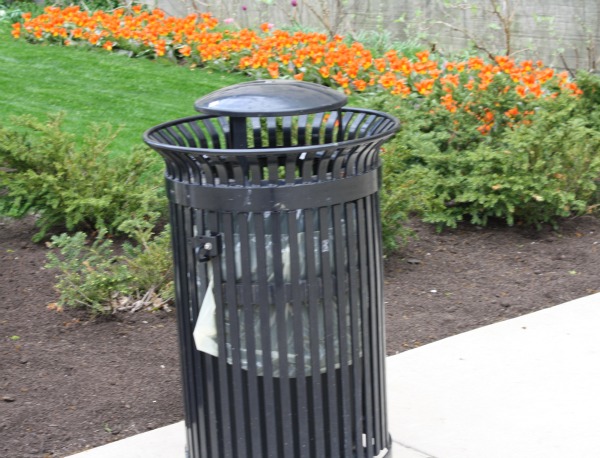
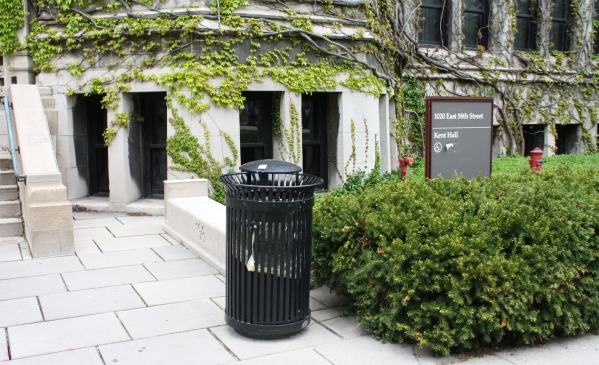


Photos by Kevin Applewhite
In October of 2010 the Young Memorial Building, home to the University of Chicago’s Facilities Services, was reopened after undergoing an extensive renovation project. The seven-month long project was intended to extend the life of the structure and make the building a healthier, more pleasant, and more sustainable place to work. To learn more about the project, find the full case study of the project on our website. Check out the pictures below to see what sustainability can look like!

The renovated foyer of the Young Building boasts vibrant colors and custom, sustainable flooring. The well-lit space ensures that the Young Building is welcoming to both Facilities Services staff and guests. The foyer also showcases current and future Facilities Services projects. Shown in this picture is the Logan Arts Center, a new, sustainably-designed center for the fine arts at the University of Chicago.
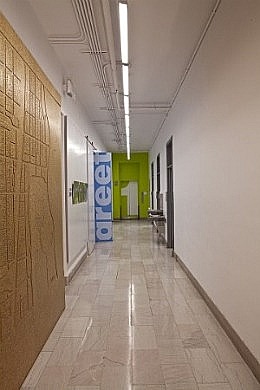
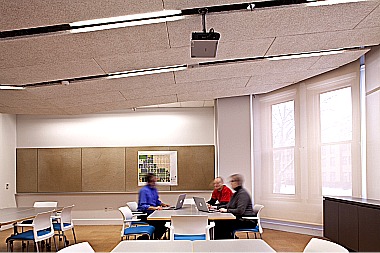
Two of the most prominent sustainability features at Young—and favorites of many occupants—are the giant campus map made out of wheat board and the cork floor in the conference room/yoga studio. Both features represent innovative resource use that is directly tied to the context of the building’s occupants: the map reflecting the work of the Facilities Services department throughout the entire campus and the cork floor providing a pleasing surface for the many employees who practice yoga every Friday.
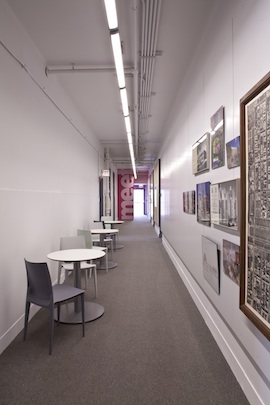
The second floor corridor represents a number of sustainable design features. Many of the lights fixtures and furniture were reclaimed from other buildings on campus while much of the new furniture included demonstration sets that were donated or sold at a discount by vendors who would have otherwise sent the furniture to a landfill.

The kitchen on the 3rd floor is stocked with dishes, glasses, water pitchers, and flatware to decrease the amount of paper and plastic disposables used in the building.

Large windows, open spaces, and the natural light they provide make the fourth floor a place for office collaboration.
Special thanks to David Woodhouse Architects for the photos.
It’s finally spring! The weather is improving, you can put your winter coat optimistically out of rotation, and farmers markets all over the city are beginning to sprout up. Farms have different offerings in the spring than they do in the summer, so here’s a brief list of fresh produce that’s available in the spring:
Asparagus: The tender, pencil sized spears of asparagus offered early in the growing season are a joy. Try baked asparagus with balsamic butter sauce or quinoa salad with roasted asparagus and white beans!
Lettuce: Fresh, crisp lettuce makes for an excellent spring salad. Make a pear, lettuce, and feta salad for lunch this week!
Fiddlehead ferns: They look a little weird, but fiddleheads are a springtime delicacy. They’re foraged, not farmed, and only available for a few weeks in April and May. Have a hankering for Asian food? Give sautéed Korean fiddleheads a try!

Green beans: One of the few beans that can be eaten raw, their peak season is in the late spring. Try shallot-thyme peas and green beans.
Peas: Gregor Mendel was well aware of the versatility of the pea, and you should be, too! While peas are in season this spring, try corn pancakes with spicy peas or spring pea tortellini.
Mustard greens: Looking to add some zest to your springtime meal? Add some mustard greens. Grilled pork medallion with preserved lemon, mustard greens and bulger wheat is a good place to start.
Spinach: Did you know that a serving of spinach has more iron than a hamburger? Maybe that is why medieval peasants anxiously awaited the spinach crop each spring after a long winter. Try sautéed spinach with garlic and lemon for a delicious appetizer.
Here is a comprehensive list of the farmers markets in Chicago this season, along with another list focusing on those opening during May—one, Green City Market, even opens today! Happy eating!
Photo courtesy of:http://ohmygoache.wordpress.com/; accessed 4 May 2011
Guest post by Christy Perera, a third year studying Environmental Studies
On April 19th, at around 4:30 in the morning, a bus pulled up in front of the Ratner Athletics Center, signaling the return of 30 student activists to campus after a fifteen-hour bus ride. These students had just returned from PowerShift, a conference that centers on environmental grassroots activism.

The majority of the students in this group are also members of the University of Chicago’s Climate Action Network, or UCAN. This RSO aims to educate students about climate change and facilitate their involvement in legislative change through lobbying, phone banking, and participation in local environmental hearings. Those who went to PowerShift were able to fully fund their trip through their partnership with UCAN and ties to Student Government. Cupcake sales, plant sales, personal donations, and even a bake sale that took place within a fraternity party enabled the students to attend PowerShift 2011.
PowerShift is a gathering of around 10,000 young people passionate about making political change and decreasing climate change. The conference, which is put on by the Energy Action Coalition, features a series of leadership trainings, workshops, lectures, and keynote speakers. The final day of the conference the newly educated leaders (conference attendees) have the opportunity to march and lobby on Capitol Hill.


The experience was no short of incredible. The ambiance of the conference was one of shared struggle, but more importantly one of strong optimism and the building of a movement. Al Gore, former vice president of the United States, encouraged the students to come together and fight for change. By Monday (if not before), the shared passions and experiences of the students had clearly united them. Thousands walked from the White House to Capitol Hill—chanting “this is what democracy looks like” and many green slogans like “all for green, green for all.” Following this march, UChicago students met with Senator Kirk’s staffers and discussed their positions on America’s green movement. Some elements of their platform included the goal of 100% clean energy and full support of the Clean Air Act.
The founder of 350.org and author of The End of Nature, Bill McKibben, summed up the message of PowerShift best: “The first thing we need to do is build a movement. We will never have as much money as the oil companies so we need a different currency to work in, we need bodies, we need creativity, we need spirit.” We are starting as a small coalition, but this group of University of Chicago of Chicago students hopes to spread that spirit and make political change.
